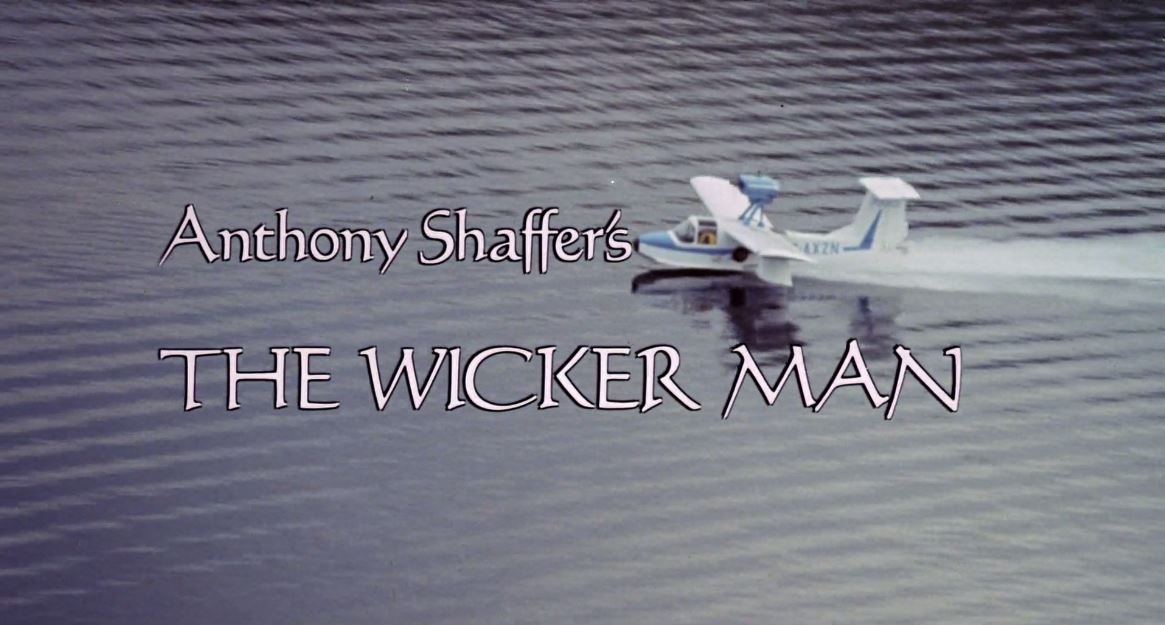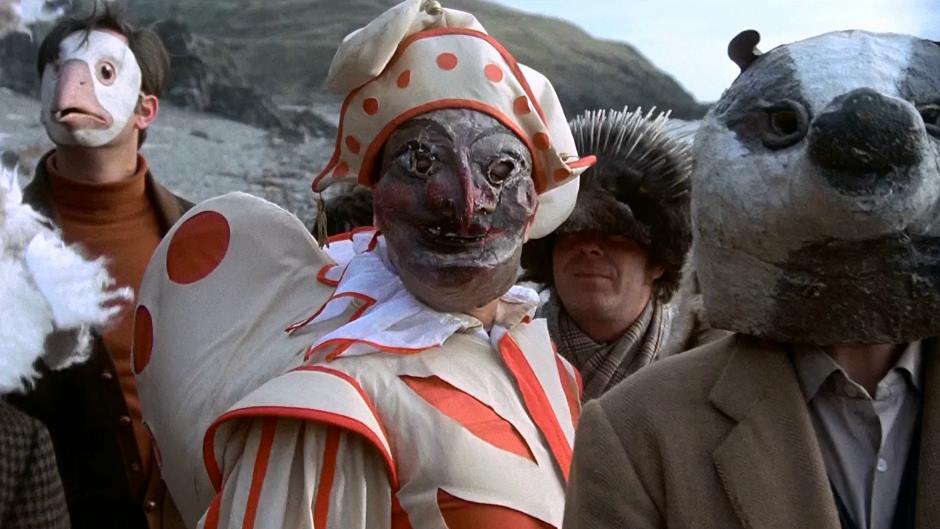
Howie (Edward Woodward) in the stolen Punch the Fool costume. The costume is highly symbolic, reflecting his unwitting manipulation at the hands of the people of Summerisle in The Wicker Man (British Lion Films, 1973)
Many accomplished horror films utilize restricted locales to evoke suspicion, anxiety, and dread. The claustrophobic space of the starship Nostromo appreciably contributed to the petrifying mood in Ridley Scott’s Alien (1979). In Rosemary’s Baby (1968), Roman Polanski centered the filmic action on an affluent New York apartment block, heightening our fears and suspicions. Stanley Kubrick’s The Shining (1980), in all probability, is the paradigmatic example of this kind of horror film. Jack Torrance (Jack Nicholson), a failing writer, accepts the winter caretaker job at the Overlook Hotel, enveloped by deep forestry. The hotel itself is a hulking edifice, composed of myriad rooms, halls, and public sitting areas. Despite this, the locale of the Overlook Hotel retains a feeling of inescapability, of incarceration, especially for Jack’s eventual prey: his son Danny (Danny Lloyd), endowed with remarkable mental powers; and Jack’s neurotic wife, Wendy (Shelley Duvall).
Such is the case with Robin Hardy’s The Wicker Man (1973). The film opens with shots of Sergeant Howie (Edward Woodward) flying in a seaplane over uninhabited isles. On its own, the journey seems like something that would appeal to a newly married couple on their honeymoon. It seems idyllic and tranquil. Though in the context of what is to come (akin to Torrance’s winding car ride to the Overlook Hotel, also shot from a helicopter above), the series of shots have a fatalistic, foreboding quality running through them. And the pagan folk music doesn’t ameliorate our apprehension. It seals it.
Howie eventually finds his way to his destination, Summerisle. The reason for his visit is to investigate the alleged disappearance of Rowan Morrison (Gerry Cowper). The residents of Summerisle are tight-lipped in the face of Howie’s barrage of questions. “No, I never saw her before,” is the typical response he receives. In fact, they are totally dismissive of his inquiries, uniformly putting up a front that they know nothing of Rowan Morrison. Even Rowan’s own mother (Irene Sunters) denies that she ever existed.
In his native Britain, Howie has been conditioned to believe he embodies the force of the law, that he is a figure of great authority. We assume he’s used to being respected and obeyed by the British populace. But Howie erroneously believes the same legal culture exists in Summerisle. When he first lands on the dock, Howie identifies himself confidently: “I, as you can see, am a police officer.” Later, in the Green Man Inn, Howie disrupts the frivolous activities the patrons are engaged in, asserting frankly, “I think you ought to know that I am on official business.” He is a man of ingrained conviction, who parochially believes all others are, or ought to have been, cut from the same cloth.
The Summerisle locals have none of Howie’s self-righteous declarations. His status as a police officer carries no significance. The men at the docks hardly feel compelled to let him onto the island. And all of the locals, without a moment’s hesitation, lie to him about their knowledge of Rowan. Policing is a foreign concept to which they don’t feel particularly bound. The only authority that exists is their pagan gods and the leader of the community, aptly named Lord Summerisle (Christopher Lee, in what he has called his preeminent performance).
As with the opening sequence, the early stages of the film ostensibly convey a peaceful, picturesque community. The fringes of the island are padded with grass and forestry, and the town has Victorian-era buildings that might be found in a quiet rural neighborhood. There are newsagents, pubs, and schools that the locals frequent. The people themselves, at first, appear civil and friendly, contented by the successes of self-governance. Gradually, this conception of Summerisle gives way to a strange kind of confusion. Rowan’s younger sister produces odd drawings of hares in the back of her mother’s shop. The patrons of the Green Man Inn – brought to life by Eric Boyd-Perkins’s clinical editing – sing “The Landlord’s Daughter” rowdily, in direct address to Howie. And the landlord’s daughter, Willow (Britt Ekland), dances erotically in an adjacent bedroom to Howie’s, in an attempt to seduce him. Some of this seems innocent enough – perhaps the people of Summerisle merely wish to enjoy themselves. But with our prior knowledge of Howie’s reasons for being there, such activities can only be interpreted as worrying. This view is reinforced by Boyd-Perkins’s referential editing; that is, the way the camera always pivots back to Howie. Hardy’s direction doesn’t merely register Howie’s perspective as the channel through which we perceive the mechanics of Summerisle. It also suggests that Howie is the focal point of these actions, that the locals have surreptitious motives of which he isn’t cognizant.
Matters only become more perplexing as the film progresses. The unsettling atmosphere established early is reconfigured into one of serious apprehension. Howie’s visit to a local school provides the best illustration of this. As he enters the grounds, he is welcomed by a class of young boys pulling on streamers connected to a totem pole. They sing the “Maypole Song,” and dance uncannily at the direction of an older, male teacher. Howie observes them from afar, and the slow pan of the camera toward him augments the disconcerting nature of the scene. He soon encounters a classroom full of girls, banging pencils on their desks to the tune of the song. The song and dance conclude, and their female teacher starts harping on about the symbolic nature of the “phallus” in their religious and cultural framework; it “symbolizes the generative force in nature,” she says. Howie stands silently in the doorway, eventually interrupting to hand out a picture of Rowan Morrison. Like the others, the girls unanimously deny they know her, but Howie finds evidence of her existence on the class roster.
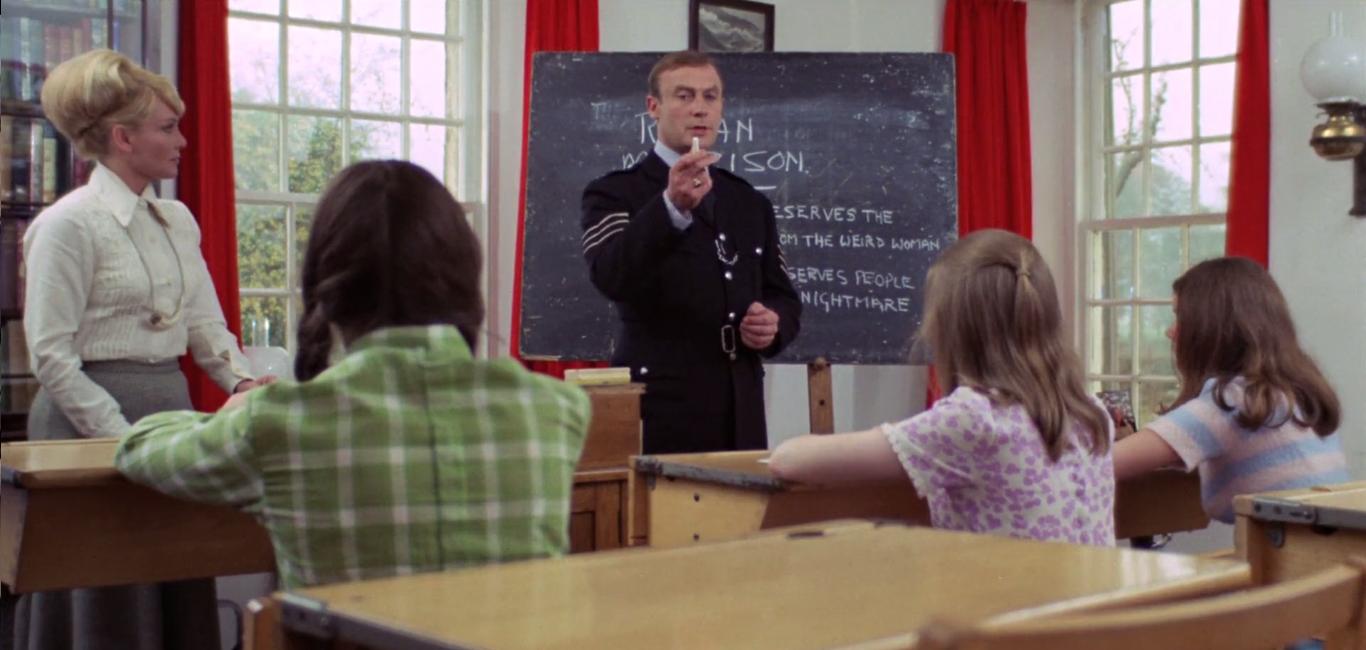
Howie (Edward Woodward) trying, without luck, to get information out of a class of indoctrinated school girls in The Wicker Man (British Lion Films, 1973)
He heads to Lord Summerisle’s manor in search of answers. More specifically, he seeks permission to exhume Morrison’s grave. Summerisle appears from behind a tall chair, surprising Howie as he stares reproachfully at naked youths frolicking in the open countryside. Their conversation soon turns to religion and cultural practice: Howie abhors the sexual freeness of the people of Summerisle, and attacks the logical foundations of their religious practice. Summerisle exerts a domineering calmness over Howie, circling and watching him like a lion might a zebra. It’s a crucially important scene, bearing similar relational dynamics to the scene in which android Roy Batty (Rutger Hauer) meets his maker, Tyrell (Joe Turkel), in Blade Runner (Scott, 1982). Except, this time, it isn’t the godlike figure who’s condemned to doom.
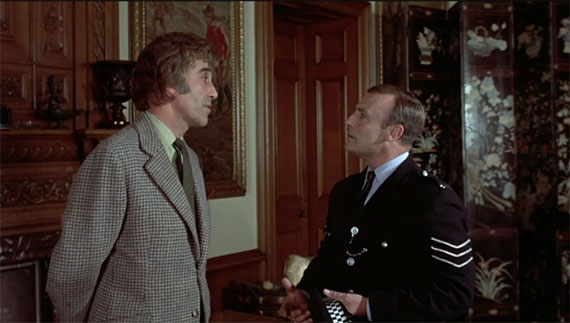
Howie’s (Edward Woodward) apparent attempt to admonish Lord Summerisle (Christopher Lee). The exchange is utterly dominated by Lee’s character in The Wicker Man (British Lion Films, 1973)
By this juncture in the film, it’s abundantly apparent that Summerisle is not just geographically distinct from the world, but also ideologically so. The principles of the place rest on gross promiscuity, unwavering obedience and an irrational worship of supposed gods. Screenwriter Anthony Shaffer has given us an unrecognizable belief system, one that is unchecked by global developments in science, sociology, religious studies, and so on. The people seem to accept anything Lord Summerisle touts, and act accordingly. In this regard, Summerisle has a Salemite feel to it, so indelibly dramatized in Arthur Miller’s play, The Crucible (1953). Though the two works are hardly parallels. While The Crucible, particularly its conclusion, is punctuated by a sense of tragedy, The Wicker Man arrests us in its grip of profound horror and alarm.
Indeed, the tenets that underpin Summerisle’s society are at odds with Howie’s personal convictions. In the prologue, we see him dressed in his best suit at a church sermon. And in his verbal skirmishes with the female teacher, Lord Summerisle, and others, Howie invariably returns to their abject rejection of Christianity. Hardly satisfied by Lord Summerisle’s claim that his people carry faith in their hearts, he disgustedly retorts, “Religious? With ruined churches, no ministers, no priests . . . and children dancing naked!” Howie’s conception of religion is rigid: it aligns only with traditional Christian teaching. And it totally informs his worldview, giving him an unimpugnable sense of what is virtuous and vicious. All the nudity, promiscuity, and the specter of Rowan’s sacrifice are denounced by reference to his Christianity.
When his Christian-driven declarations are considered against the backdrop of history, however, Howie’s disposition produces an awkward, ironic effect. This is, of course, because Christianity has found itself complicit in many unjustifiable, egregious acts of terror, repression, and violence. In some cases, Christian belief has motivated agents to such action. The infamous events of the Salem Witch Trials – which Miller himself described as “one of the strangest and most awful chapters in human history” (2) – were propelled by a seemingly implacable Christian anxiety about the insidious effects of the Devil. Christianity has also pushed theocrats to disavow scientific developments, labelling any proponent of science a “heretic,” just as Galileo Galilei was (also fictionalized in Bertolt Brecht’s play, Galileo (1938)). In contemporary times, the Christian faith bore the Ku Klux Klan, vehemently denied the processes of biological evolution, and some even claimed that the AIDS epidemic of the late twentieth century was divine punishment for those who pursued homosexual relations. The greatest logical contradiction inherent in Howie’s Christian worldview is displayed when he decries the prospect of human sacrifice in Summerisle.
After his fated meeting with Lord Summerisle, Howie discovers that a human sacrifice is offered to the pagan gods when the past year’s harvest is meager, to be performed during the May Day celebrations. In light of this, Howie subdues the landlord of the Green Man Inn in order to take his Punch the Fool costume and rescue Rowan during the celebrations. No doubt, Howie’s inclinations to prevent an apparently futile death lead him in the right moral direction. But it doesn’t mean they don’t ring with irony: since his own savior and idol, Jesus Christ, willed himself to die on the cross to save the whole of humanity. This is a teaching Howie believes; as the people of Summerisle correspondingly believe a human sacrifice is needed for the island’s crops to flourish.
Indeed, much of what occurs in The Wicker Man deserves to be condemned on moral and epistemological grounds. Hardy and Shaffer’s constant invocation and cross-examination of Howie’s Christian faith ensures that such commentary isn’t confined to the fictional world of Summerisle. Rather, it’s manifested in a self-consciously hyperbolic way, copiously illustrating the foibles of uncritical, intense belief, particularly within the religious sphere. Extremism – whether of a Christian, religious, or perhaps political sort – is bound to compel otherwise, one would hope, rational creatures to commit lamentable acts of undue cruelty and barbarism.
That isn’t all Hardy and Shaffer have to say about Christianity. It’s also considered in the context of the conservative fabric of modern Britain. Sergeant Howie is a clear embodiment of Britain’s conservative roots; he is a devout Christian, a police officer, and a middle-aged Anglo-Saxon male. His views, constituted by all of these factors, likely reinforce historical status quos around class, gender, and race. It certainly explains his repulsion toward the sexual liberty that the Summerisle people harness – having sexual relations in public in the dark of night, cavorting around naked, and being taught the power of the sexual drive at school. His own sexual repression – evidenced by his virginal status – is starkly contrasted with their converse freeness. The film’s sexual dynamics perhaps serve an allegorical purpose: to predict that the reign of conservative ideology – of sexual and gender relations specifically – was approaching its end. For, in the preceding decade, the West saw a cultural revolution that swept its younger generations up in the activities of music festivals, drug use, environmental activism, and sexual autonomy. Though Hardy and Shaffer weren’t to foresee, the 1980s Thatcher milieu hastily overturned the decay of English conservatism, returning it to its former glory of the Churchill years.
Despite many setbacks and disappointments, novelist-turned-filmmaker Robin Hardy certainly made a resounding splash with The Wicker Man. British Lion Films mandated that Hardy work with a £500,000 budget. This meant its star villain, Christopher Lee, and others, had to work for free. In the middle of production, EMI Films took over as the film’s production company, and exercised executive control over Hardy’s theatrical cut by keeping it to eighty-seven minutes. And in the last gasps of the double billing mode of film distribution, The Wicker Man played in cinemas immediately after Nicolas Roeg’s Don’t Look Now (1973). None of this, now, has dented the endurability of Hardy’s film. Neither has Neil LaBute’s unfortunate remake; if anything, it reminded us of the multilayered brilliance of its predecessor. The now-defunct film magazine Cinefantastique heralded it as “The Citizen Kane (Welles, 1941) of horror movies” (Bartholomew 4). To my mind, it’s the potent mix of thought-provoking material and its genuinely nightmarish aesthetic that artistically validates Hardy’s direction. Even in its truncated eighty-seven-minute version, The Wicker Man impels us to ponder its details, while providing us cause never to return to its terror-inducing embrace again. It can even be tenably argued this iteration is tightly wound, apt to effectively hold us in its vicelike grip.
Even in its final, immortalizing moments, The Wicker Man doesn’t resort to the gratuitous violence and gore characteristic of so many 1970s horror films. This was a firm decision made by Anthony Shaffer, to circumvent the banal predictability of the modern horror film. And circumvent it, it did. The thrust of The Wicker Man lies with its evocation of atmosphere, which Hardy modulates seamlessly to inspire in us appropriate sensibilities across the duration of the film. Uneasiness slides into apprehension. The final act, one of the most memorable in all of horror cinema, overwhelms us in a state of unconquerable alarm. Though it doesn’t leave us with physical injury – as no film is capable of doing – Hardy’s film inflicts mental scars, tattooing its harrowing conclusion into the fibers of the mind.
Once he’s donned the symbolic costume, Howie tries to fit in with the crowd. He dances and bides his time to find Rowan. At last, she appears in an angelic white dress with her hands tied, atop some rock. He rushes to Rowan and frees her, saying, “Don’t be frightened, I’m a police officer.” They run through a cave together, to what Howie assumes will be safety. Instead, she leads him to a cliff, where Lord Summerisle, Willow, and the others wait. Rowan’s been in on the plan from the start. “You came here to find Rowan Morrison but it is we who have found you . . . and controlled your every thought and action since you arrived,” declares Lord Summerisle, in a way that underlines his untrounced victory. Howie looks for modes of escape, but none is forthcoming. Jumping from the cliff would condemn him to a nasty death. Otherwise, he is surrounded by the fanatical people of Summerisle, who aren’t about to let him pass.
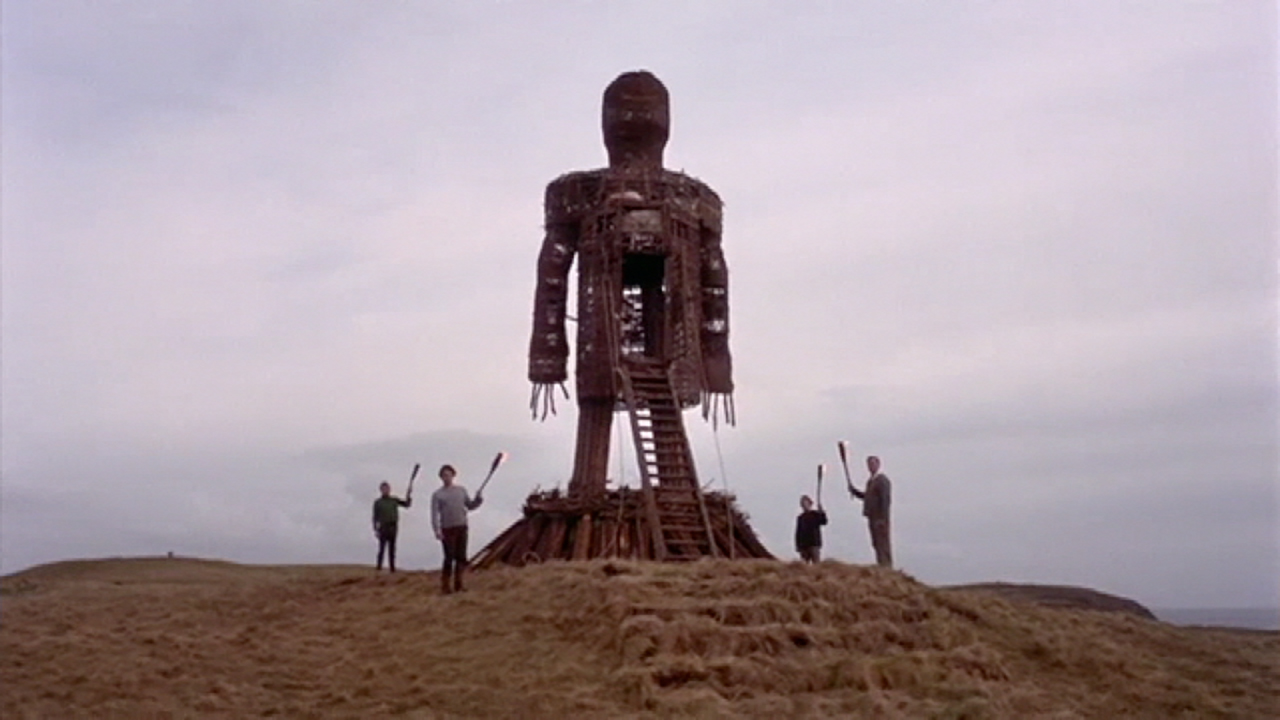
The Wicker Man (British Lion Films, 1973), in all of its horror. Seen from Howie’s (Edward Woodward) perspective
At first, Howie is stoic in the face of death. He takes comfort in his Christian faith. This disposition evaporates quickly, and he begins desperately appealing to the crowd’s faculties of reason: “There is no Sun God . . . Don’t you see killing me is not going to bring back your apples?” They’re unmoved, unreachable by way of their immutable convictions. Howie’s sacrifice will yield great amounts of fruits to satisfy the people of Summerisle. He’s hauled before the eponymous Wicker Man, which we first see from a distance that registers its imposing, tormenting stature. Along with some livestock, Howie’s thrown into the bowels of the Wicker Man. The structure is ignited, as Summerisle and his followers watch on with glazed eyes; an image of pure fanaticism. Howie howls out in anguish, and when the crowd break out in cheery song (“Sumer Is Icumen In” – reharmonized to devastating effect by the Summerisle congregation), Howie takes to singing church songs. Eventually, seen in a close-up, the fire renders the Wicker Man decapitated, leaving the sunset in the midst of the frame. An image of this kind would usually signal beauty, or peace between the characters. Here, the sun simmers wrathfully, sounding the death knell of organized society when zealotry is allowed to spread unchecked.
Works Cited
Miller, Arthur. The Crucible. New York: Viking Penguin Inc., 1953. Print.
Bartholomew, David. “The Wicker Man.” Cinefantastique 6.3 (1977): 4-19: Print.
Author Biography
Nick Bugeja is an Arts/Law student who is majoring in Film and Screen Studies at Monash University. He is an aspiring film critic and writer. Nick particularly enjoys the films of Paul Schrader, Robert Altman, Akira Kurosawa, and Ivan Sen.
Film Details
The Wicker Man (1973)
England
Director Robin Hardy
Runtime 87 Minutes

